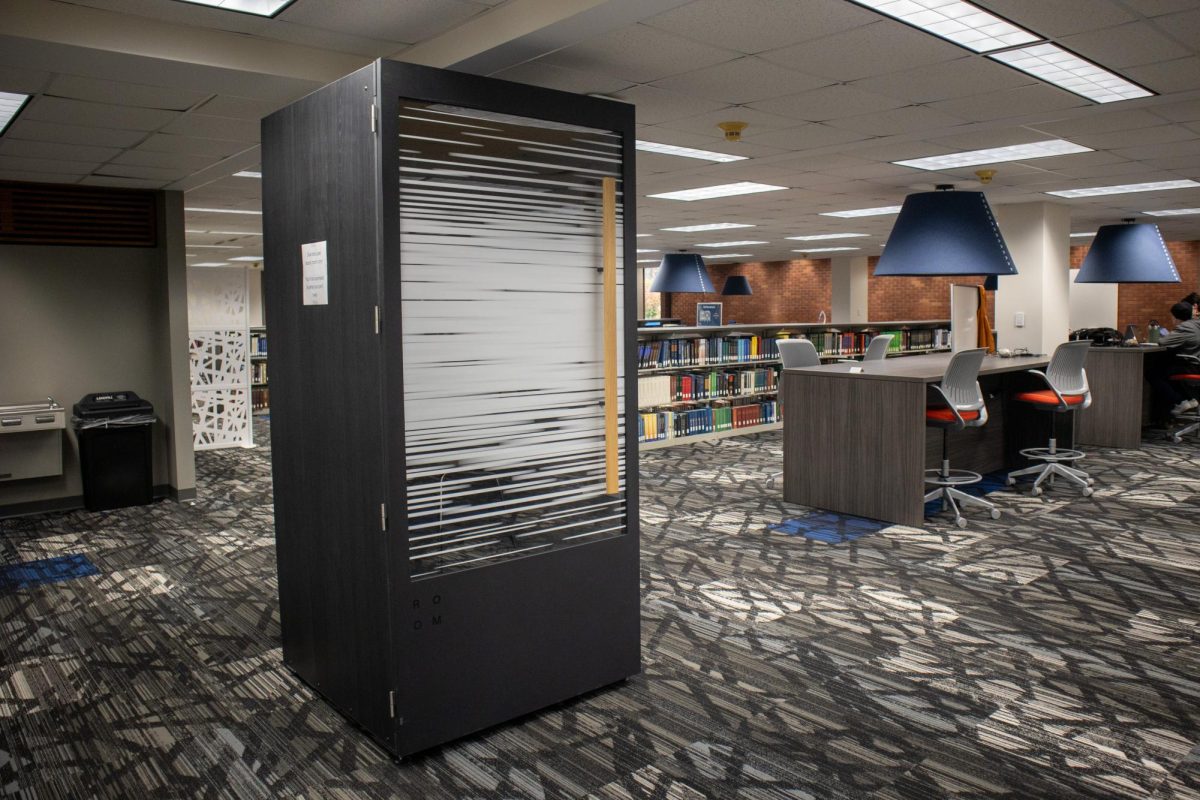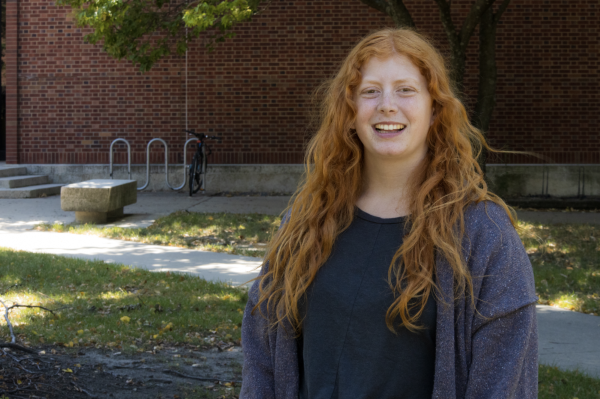Cowles Library staff and patrons alike take in a mysterious pod that unexpectedly appeared next to the New Arrivals shelving one day. Inside this mysterious box is a sensory-friendly study space.
With soundproof technology, a library patron can step inside and block out the rest of the library without extra effort. This pod is called a Framery and is the latest in sound-proof technology from the company of the same name. Michelle Huggins, Drake’s planning and design manager, said the University is considering buying one or more Framerys, so they are eager to hear student feedback regarding the temporarily installed Framery.
“The quality of them is very high in limiting sound,” Huggins said. “You can tell that someone’s talking, but you typically cannot tell what they are saying, so you can use them if you need that level of acoustic sound control or if you just need a place to go and desensitize.”
The pods are fairly expensive, so Huggins said she wants to ensure students would use these spaces before investing in them. Currently, Drake has an opportunity to test out the Framery. Drake’s furniture vendors gave the University 24 hours to get the model in the library and will allow the University to keep it for a month. Drake jumped at this opportunity because it would enable it to get the desired feedback.
“We love to extend [new inventions like Framery] to our students, especially if it’s something new in the industry that maybe we don’t have anywhere,” Huggins said. “Our furniture designers are trying to figure out if this is a good piece to take to market. We want to be the testers for what’s working and what’s not.”
The input of this room coincides with the University’s wellness committee’s mission to input sensory-friendly spaces in every college on campus. Laura Shell, strategic director of student success and retention and wellness committee member, said the committee started by placing a sensory-friendly room in the basement of Olmsted near the Underground while prioritizing other initiatives, such as the wellness conference and peer mentoring; they are still working towards that goal.
Shell said they strive to do this because Access and Success is hearing more from students about their sensory needs. Students are requesting spaces like these more and more.
“People are able to articulate their needs in these ways, so being able to say to a student, ‘Here is a place you can go. Here is an option that is helpful for you.’ Within this space, we try to think about what might help a student in that room,” Shell said. “We are hearing a need, and we are trying to address the need. We are also trying to be intentional about putting the right support in place at the right time.”
When Drake was renovated in 2018, the University prioritized creating diverse study zones. They wanted something for everyone from both an acoustical and visual standpoint. Huggins said that 95% of the University’s goals were reached, and the remaining five percent related to installing these Framery spaces.
“We need to provide many amenities in different places for students to learn how to be an adult and study their academics,” Huggins said. “All those things take a variety of spaces.”
Huggins said the University wants to invest in these spaces because the Framery is small and can be used in nearly any space on campus. Additionally, Huggins said buying and installing these pods is much cheaper and more efficient than building an entirely new room.
“They work nicely, come in different sizes and work very well with existing mechanical and electrical systems,” Huggins said. “So [it’s] that versus building a separate room with standard construction materials. They are easier to install and are more flexible than if you have to build something in place.”
These rooms are very customizable. The manufacturer chose the features of the current model in the library, but various aspects can be changed to fit student preferences. Huggins is looking for feedback on two aspects: the size and door type.
Right now, the vinyl sticker on the door is the striped version that gives the person inside privacy but still allows light from the room to enter. These pods can also come with clear, completely see-through doors or vinyl stickers that offer more coverage.
“We have found in other similar types of rooms some level of frosted glass, some type of transparency has always been desired just so that you don’t feel like you’re on display,” Huggins said.
In terms of size, the pod in the library right now is for one person, but there are options for meeting rooms that can accommodate up to six people. Based on student feedback, Huggins said they would get the pods with options to seat larger groups.
Students can test the study space out and write their feedback on whiteboards in Cowles Library. Photographs will be routinely taken, and the whiteboards will be cleared for maximum feedback. Huggins said that Drake has learned that low-tech systems like this are the most effective way to collect student feedback.
“Hopefully, the feedback is ‘I [would] really like it if it was about two times as big,’” Huggins said. “That’s what I’m guessing that feedback is going to be. They like the use of it, they like the individuality of it, but probably a little bit too small for what they would need.”
If feedback is positive and Drake decides to purchase a Framery permanently, Huggins said it should arrive in about 4 to 6 months after they raise funds and place the order.
“Our donor group is extremely generous, so I imagine our development team would be able to raise those funds fairly quickly,” Huggins said.








